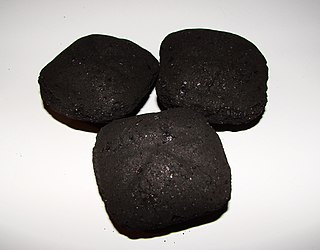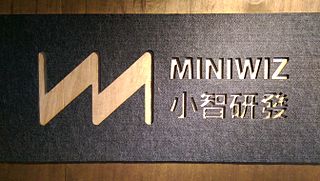
Straw is an agricultural byproduct consisting of the dry stalks of cereal plants after the grain and chaff have been removed. It makes up about half of the yield of cereal crops such as barley, oats, rice, rye and wheat. It has a number of different uses, including fuel, livestock bedding and fodder, thatching and basket making.

A composite material is a material made from two or more constituent materials with significantly different physical or chemical properties that, when combined, produce a material with characteristics different from the individual components. The individual components remain separate and distinct within the finished structure, differentiating composites from mixtures and solid solutions.

Oriented strand board (OSB), also known as flakeboard, sterling board and aspenite in British English, is a type of engineered wood similar to particle board, formed by adding adhesives and then compressing layers of wood strands (flakes) in specific orientations. It was invented by Armin Elmendorf in California in 1963. OSB may have a rough and variegated surface with the individual strips of around 2.5 cm × 15 cm, lying unevenly across each other and comes in a variety of types and thicknesses.

Medium-density fibreboard (MDF) is an engineered wood product made by breaking down hardwood or softwood residuals into wood fibres, often in a defibrator, combining it with wax and a resin binder, and forming panels by applying high temperature and pressure. MDF is generally denser than plywood. It is made up of separated fibres, but can be used as a building material similar in application to plywood. It is stronger and much denser than particle board.

Straw-bale construction is a building method that uses bales of straw as structural elements, building insulation, or both. This construction method is commonly used in natural building or "brown" construction projects. Research has shown that straw-bale construction is a sustainable method for building, from the standpoint of both materials and energy needed for heating and cooling.

A briquette is a compressed block of coal dust or other combustible biomass material such as charcoal, sawdust, wood chips, peat, or paper used for fuel and kindling to start a fire. The term derives from the French word brique meaning brick.

Green building refers to both a structure and the application of processes that are environmentally responsible and resource-efficient throughout a building's life-cycle: from planning to design, construction, operation, maintenance, renovation, and demolition. This requires close cooperation of the contractor, the architects, the engineers, and the client at all project stages. The Green Building practice expands and complements the classical building design concerns of economy, utility, durability, and comfort.

Sustainable architecture is architecture that seeks to minimize the negative environmental impact of buildings by efficiency and moderation in the use of materials, energy, and development space and the ecosystem at large. Sustainable architecture uses a conscious approach to energy and ecological conservation in the design of the built environment.
Ecodesign is an approach to designing products with special consideration for the environmental impacts of the product during its whole lifecycle. In a life cycle assessment, the life cycle of a product is usually divided into procurement, manufacture, use, and disposal.
Green waste, also known as "biological waste," is any organic waste that can be composted. It is most usually composed of refuse from gardens such as grass clippings or leaves, and domestic or industrial kitchen wastes. Green waste does not include things such dried leaves, pine straw, or hay. Such materials are rich in carbon and considered "brown wastes," while green wastes contain high in concentrations of nitrogen. Green waste can be used to increase the efficiency of many composting operations and can be added to soil to sustain local nutrient cycling.

Building insulation is any object in a building used as insulation for any purpose. While the majority of insulation in buildings is for thermal purposes, the term also applies to acoustic insulation, fire insulation, and impact insulation. Often an insulation material will be chosen for its ability to perform several of these functions at once.

Building insulation materials are the building materials which form the thermal envelope of a building or otherwise reduce heat transfer.

Sustainable engineering is the process of designing or operating systems such that they use energy and resources sustainably, in other words, at a rate that does not compromise the natural environment, or the ability of future generations to meet their own needs.
Products made from a variety of materials can be recycled using a number of processes.
Sustainability organizations are (1) organized groups of people that aim to advance sustainability and/or (2) those actions of organizing something sustainably. Unlike many business organizations, sustainability organizations are not limited to implementing sustainability strategies which provide them with economic and cultural benefits attained through environmental responsibility. For sustainability organizations, sustainability can also be an end in itself without further justifications.

Miniwiz is an Internationally operating and privately owned company dedicated to upcycling consumer trash and industrial waste. It creates low carbon footprint materials, semi-finished goods and building modules suitable for uses ranging from construction to consumer products. The company was established in 2005.
Gypsum recycling is the process of turning gypsum waste into recycled gypsum, thereby generating a raw material that can replace virgin gypsum raw materials in the manufacturing of new products.
Atlantic County Utilities Authority (ACUA) is a public agency in Atlantic County, New Jersey, that is responsible for enhancing quality of life through the protection of waters and lands from pollution by providing responsible waste management services.
Oriented structural straw board (OSSB) is an engineered board that is made by splitting straw and formed by adding formaldehyde-free adhesives and then hot compressing layers of straw in specific orientations. Research and development for OSSB panels began in the mid 1980s and was spearheaded by The Alberta Research Council, Canada which identified the straw strand manufacturing technology using formaldehyde-free (p-MDI) adhesives.















